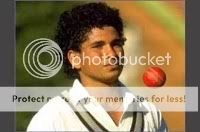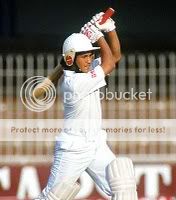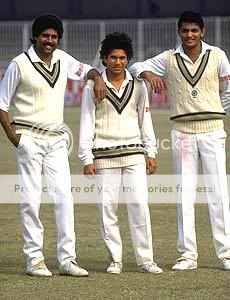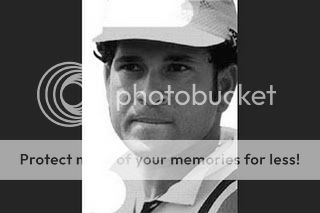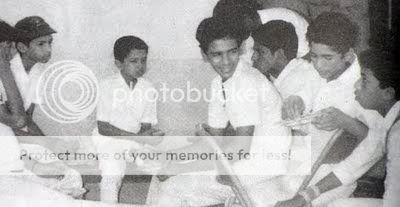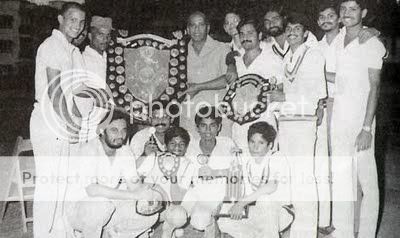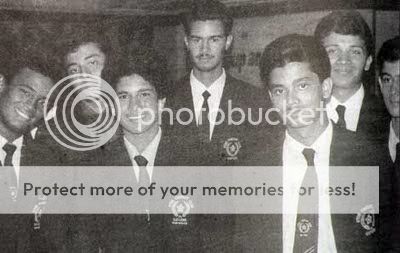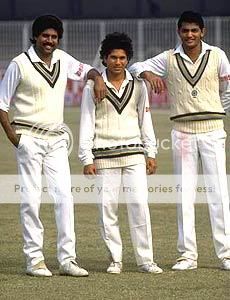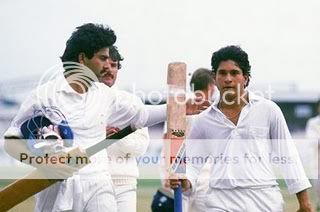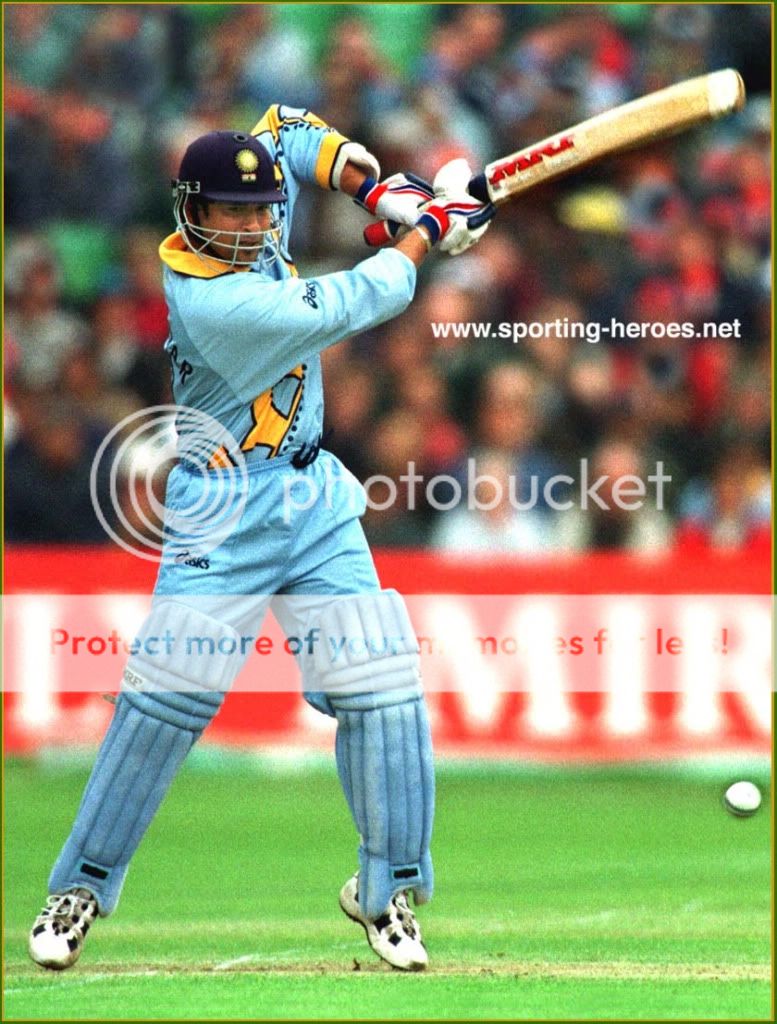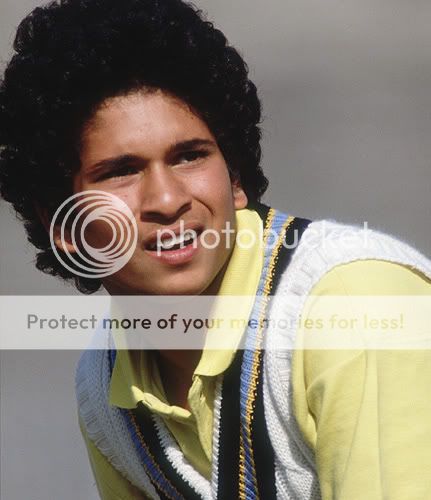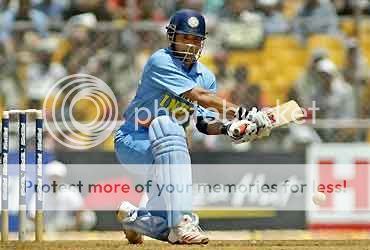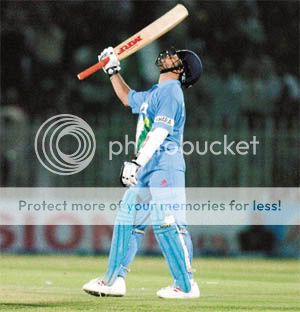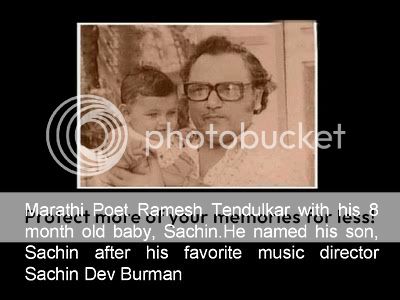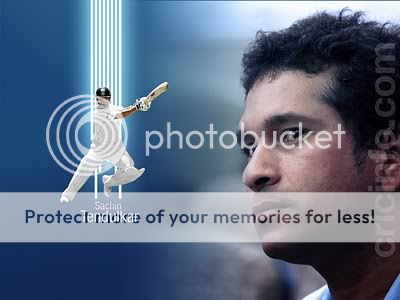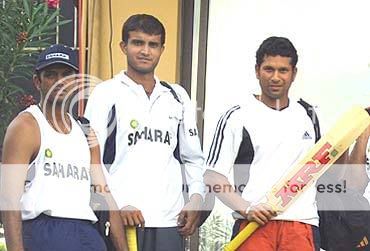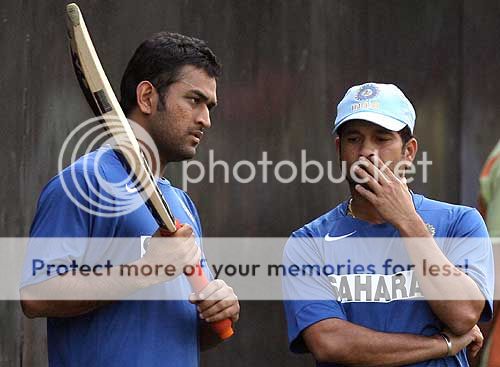SAchin with his Kids and his wife and MOM

Mumbai : Cricketer Sachin Tendulkar arrived here on Wednesday night to a hero's welcome from family and friends.
They greeted the batting maestro with a surprise reception at his residence in suburban Bandra.
An overwhelmed Sachin told waiting reporters that ''this is a special occasion, as my mother is there to bless me and other family members are also present.'' Sachin said he had seen banners and hoardings greeting him on his world record of Test centuries.
During the second cricket Test against Sri Lanka in New Delhi, which concluded on Wednesday, Sachin surpassed the 34 centuries record of Sunil Gavaskar. Sachin later helped his children Arjun and Sara cut a special cake to celebrate his 35th ton. His wife, Anjali, was also present. Outside the building, Sachin's fans burst firecrackers to celebrate their idol's new world record. ' PTI




In a two-decade long career, the only bouncer Sachin Tendulkar found tough to negotiate came from his own son, who would refuse to speak to him on phone during tours out of sheer annoyance over his absence from home.
Tendulkar, who will complete two decades in international cricket in November, disclosed that his son did not like him leaving home frequently and wouldn't come on phone until six years of age.
"It was tough initially because my son did not like it when I left home. For the first five-six years of his life, he did not speak to me on phone. That was difficult for me," Tendulkar said.
"Now he (Arjun) knows what I do and he appreciates that; so that's nice. I am a family man and they now know that I play cricket for India," he added.
Asked whether he wanted his son to follow in his footsteps and become a cricketer, Tendulkar said he would not force Arjun to play the game.
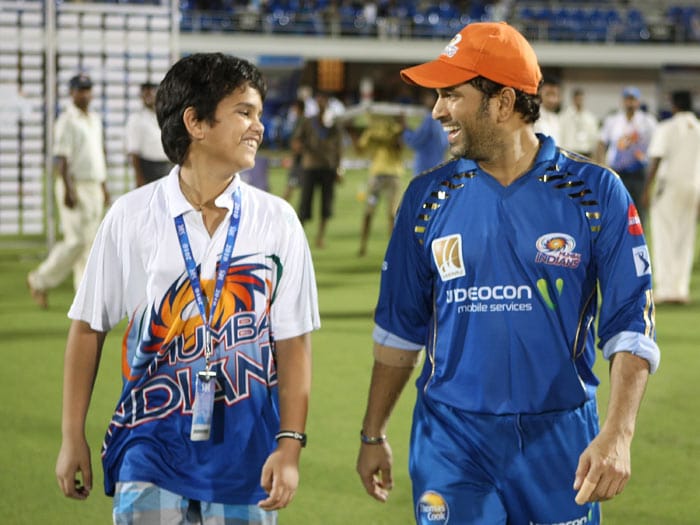


Sara Tendulkar and Arjun Tendulkar, the rising star kids of Indian batting maestro Sachin Tendulkar have showcased their affection and immense pride in their father's achievements in the international cricketing world. As a matter of fact, it has been witnessed at numerous times in public how much the kids dote on their father Sachin.
Whether it is the various cricket matches being attended by son Arjun Tendulkar [ who recently made his cricketing debut in January 2010] or it is the social welfare events organized by daughter Sara Tendulkar [ she decided to spend her birthday with slum kids]. There are various such instances where one can see the kids alighted with their father's presence.
The Tendulkars have never shied away from showcasing their bond of togetherness and mutual admiration for each other in the public eye. When Sachin completed his 20 years in international cricket then his kids sent him gifts for celebrating the occasion. His daughter Sara gifted him with a painting while his Arjun sent him personally made greeting cards. This was all sent through their mother and Sachin's wife Anjali Tendulkar who went to pay her husband a visit in Ahmedabad.
When Sara took part in the 7th Standard Chartered Marathon in Mumbai last year, Sachin gave her a sound advice to focus and run. Sara who became the highest Dream Maker by raising a larger amount of funds for her grandmother's NGO was elated to hear her father's praise on this occasion.
Everyone who knows the Tendulkars was taken in by surprise by last year when the oldest of the junior Tendulkar kids became the first news maker of the year 2010. Yes, it was Sara Tendulkar who came into limelight and not her father Sachin when the headstrong girl participated in the 7th Standard Chartered Mumbai Marathon on January 12 2010 under Dream Run Category.
Apparently Sara Tendulkar the beloved daughter of legendary Indian cricketer Sachin Tendulkar took part in the marathon for a noble cause. She was there to raise funds for her grandmother and Sachin Tendulkar's mother in law Annabel Mehta's NGO called Apnalaya.
According to her mother Anjali and grandmother Annabel, Sara was really moved by the emotional environment there at the marathon. Also, she was really taken in by surprise by all the mayhem and fervor present amongst the participants at the event. She was enthusiastic throughout the marathon and even clicked pictures with the fellow participants.
Not surprisingly she managed to raise rupees 5.88 lakhs for Apnalaya a figure which managed to won her the award of the youngest Dream Maker of the marathon. She was ecstatic to achieve the award and do something for her grandmother's NGO.
This is not the first instant when Sara has shown concern for social causes. In the year 2009 on her 11th birthday on 12th October, she told her parents to spend her birthday with the underprivileged kids of slum Govandi in Mumbai and even shared her goodies with them. This took Sachin by pleasant surprise and moved him dearly.
For the upcoming 2011 Marathon, Sara earlier reported that she undergoes training for this type f marathon. Sara Tendulkar is the eldest daughter of cricket maestro Sachin Tendulkar and Anjali Tendulkar and has a kid brother Arjun Tendulkar who is following in his father's footsteps!
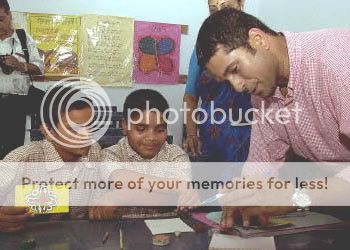
Sachin Tendulkar Takes up Educational Charity in Mumbai | |
Mumbai, Jun 4: Taking an inspiration from his late father who was committed to certain social responsibilities, India's batting maestro Sachin Tendulkar has decided to sponsor the education of 200 children, who are part of Anapalya, a non-governmental organisation (NGO) in Mumbai. A formal function to mark this dedication by Tendulkar was organised here on Wednesday. Addressing a press conference under the Give India campaign, conceptualised by another NGO, Tendulkar said that during his childhood every penny in his house mattered but his father, a teacher by profession, made sure that a newspaper boy who used to deliver newspapers in the colony should be provided with money so that he could pursue his college career.
He say he believed that the 'Joy of Giving Week' campaign that takes place between September 27- October 4 every year will aim to induce people from all walks of life to donate money, time or simple acts of kindness making the society and the country a happier place to live in. "Such things in life can make a huge difference not only to us as an individual but if you are looking at the entire nation and if every individual decides to take responsibility then it's going to be a happier place," he added. Tendulkar is considered to be the greatest batsmen in the cricket history being the highest run scorer in both Test matches and One Day Internationals, and also the batsman with the most centuries in either form of the game for India. Cricket Star Sachin Tendulkar joins with UNICEFWorld famous Indian batsman Sachin Tendulkar has joined with UNICEF to encourage children to improve their health and hygiene. The Master Blaster, Tendulkar, features in a PSA for the inaugural Global Handwashing Day. The PSA is targeted at students and will be broadcast this month across India in fourteen different languages. 'Having two young children, I constantly have to remind them to wash their hands before and after meals. I wanted to be a part of this campaign, because washing hands with soap can keep children safe and healthy and protect them against deadly disease,' Tendulkar said. |
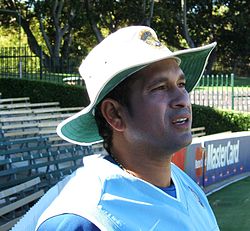 | ||||
| Personal information | ||||
|---|---|---|---|---|
| Full name | Sachin Ramesh Tendulkar | |||
| Born | 24 April 1973 (age 38) Bombay, Maharashtra, India | |||
| Nickname | Little Master, Tendlya,[1] The God of Cricket,[2] Master Blaster,[3] The Master,[4][5] The Little Champion,[6] | |||
| Height | 5 ft 5 in (1.65 m) | |||
| Batting style | Right-handed | |||
| Bowling style | Right-arm leg spin, off spin, medium pace | |||
| Role | Batsman | |||
| International information | ||||
| National side | India | |||
| Test debut(cap 187) | 15 November 1989 v Pakistan | |||
| Last Test | 2 January 2011 v South Africa | |||
| ODI debut(cap 74) | 18 December 1989 v Pakistan | |||
| Last ODI | 2 April 2011 v Sri Lanka | |||
| ODI shirt no. | 10 | |||
| Domestic team information | ||||
| Years | Team | |||
| 1988–present | Mumbai | |||
| 2008–present | Mumbai Indians (Indian Premier League) | |||
| 1992 | Yorkshire | |||
| Career statistics | ||||
| Competition | Test | ODI | FC | LA |
| Matches | 177 | 453 | 280 | 540 |
| Runs scored | 14,692 | 18,111 | 23,585 | 21,663 |
| Batting average | 56.95 | 45.16 | 59.86 | 45.89 |
| 100s/50s | 51/59 | 48/95 | 77/105 | 59/113 |
| Top score | 248* | 200* | 248* | 200* |
| Balls bowled | 4,096 | 8,032 | 7,461 | 10,220 |
| Wickets | 45 | 154 | 70 | 201 |
| Bowling average | 53.07 | 44.32 | 59.86 | 42.11 |
| 5 wickets ininnings | 0 | 2 | 0 | 2 |
| 10 wickets in match | 0 | n/a | 0 | n/a |
| Best bowling | 3/10 | 5/32 | 3/10 | 5/32 |
| Catches/stumpings | 106/– | 136/– | 174/– | 171/– |
Early Domestic career of Sachin Tendulkar
Sachin attended the MRF Pace Foundation during his schooldays to train as a fast bowler, but Australian fast bowler Dennis Lillee, who saw him training, was not much impressed and suggested that Tendulkar should focus on his batting instead. As a young boy, Tendulkar would practice for hours at the net, and was driven hard by his coach Achrekar.
While at school, his extraordinary batting skills got noticed by the sports circuit. People felt that the young boy would soon become one of the greats in cricket. In the 1988 season, he scored a century in every inning that he played. In one of the inter school matches that year, he had an unbroken 664-run partnership with friend and team mate Vinod Kambli.
When he was 14, Indian batting legend Sunil Gavaskar a great Indian batsman of that time, gave him a pair of his own light pads. This touching gesture greatly encouraged the budding cricketer, who 20 years later broke Gavaskar's world record of 34 Test centuries.
In 1988, when he was just under 16, he scored 100 not out in for Bombay against Gujrat. This was on his first-class debut. He then scored a century in his first appearance in the Deodhar and Duleep Trophy. Mumbai captain Dilip Vengsarkar picked him up after seeing him batting Kapil Dev in the nets. That season he was Bombay's highest run-getter. In the Irani Trophy final, He made an unbeaten century. He scored a century in all three of his Irani Trophy, Ranji Trophy and Duleep Trophy debuts, and became the first player to do so. He was selected for the tour of Pakistan next year.On 11 December 1988, aged just 15 years and 232 days, Tendulkar scored 100 not out in his debut first-class match for Bombay against Gujarat, making him the youngest Indian to score a century on first-class debut. He followed this by scoring a century in his first Deodhar and Duleep Trophy. He was picked by the Mumbai captain Dilip Vengsarkar after seeing him negotiate Kapil Dev in the nets, and finished the season as Bombay's highest run-scorer. He also made an unbeaten century in the Irani Trophy final, and was selected for the tour of Pakistan next year, after just one first class season.
His first double century was for Mumbai while playing against the visiting Australian team at the Brabourne Stadium in 1998. He is the only player to score a century in all three of his Ranji Trophy, Duleep Trophy and Irani Trophy debuts.
In 1992, at the age of 19, Tendulkar became the first overseas born player to represent Yorkshire
Tendulkar played 16 first-class matches for the county and scored 1070 runs at an average of 46.52.
